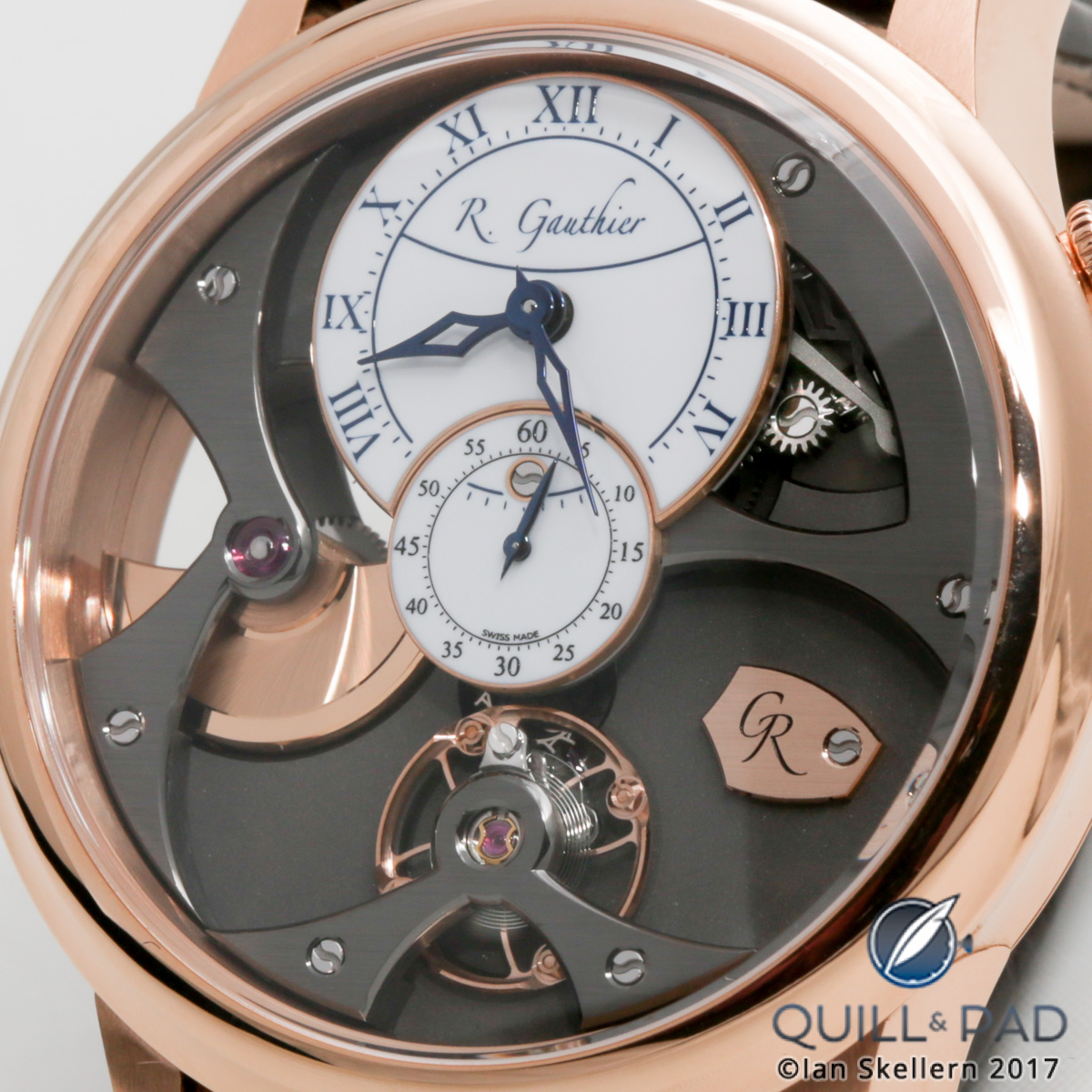One of TAG Heuer’s most popular watches has been updated for 2012/ 2013- the Aquaracer 500m watch. The new model brings several improvements from the current series, most notably the use of a slimmer case and a new ceramic bezel.
The automatic Aquaracer range used to be straightforward, with two distinct choices: a case design evolved from the original Heuer/ TAG Heuer 2000 (rated to water resistance of 300m), or a larger, more angular case (rated to 500m) that boasted an innovative rubber bezel and helium escape valve. Now with the 2012 Aquaracer 500m, those lines have been blurred.
 The second generation 500m is based on the Aquaracer 300m, rather than being a distinct design. While the new watch looks great, it’s now a variation of the other Aquaracers- so does that mean the new series a step forwards or backwards?
The second generation 500m is based on the Aquaracer 300m, rather than being a distinct design. While the new watch looks great, it’s now a variation of the other Aquaracers- so does that mean the new series a step forwards or backwards?
History
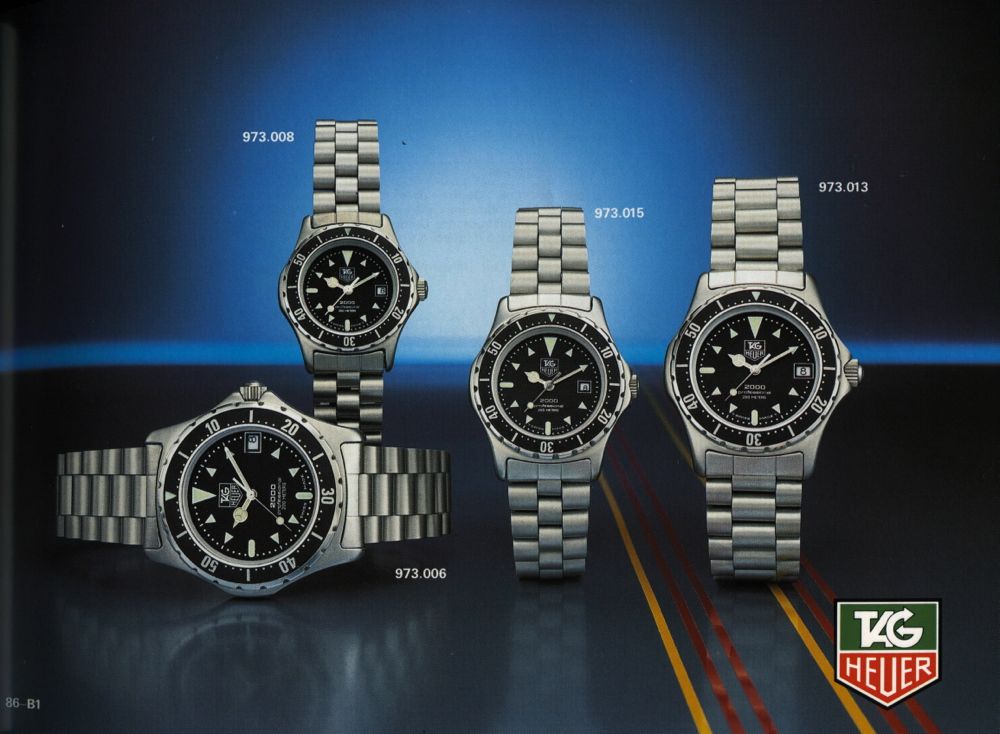 As regular readers will know, the Aquaracer series began its life as the Heuer 2000 series in 1982. The 2000 was the last watch released by Heuer under the stewardship of Jack Heuer, and evolved into the TAG Heuer 2000 in 1986 (above). As part of the new naming strategy to distance TAG Heuer from the 1000/ 15000/ 2000/ 4000/ 6000 era, the 2000 series was relaunched as the Aquaracer at the end of 2004.
As regular readers will know, the Aquaracer series began its life as the Heuer 2000 series in 1982. The 2000 was the last watch released by Heuer under the stewardship of Jack Heuer, and evolved into the TAG Heuer 2000 in 1986 (above). As part of the new naming strategy to distance TAG Heuer from the 1000/ 15000/ 2000/ 4000/ 6000 era, the 2000 series was relaunched as the Aquaracer at the end of 2004.
The 2000/ Aquaracer models always stayed true to the original case design, simply updating movements, finishes and dial designs along the way. This changed in 2009 when the Aquaracer 5oom family was launched- here was a larger, squared-edged case with a rubber bezel, over-sized crown and helium-escape valve (see below).
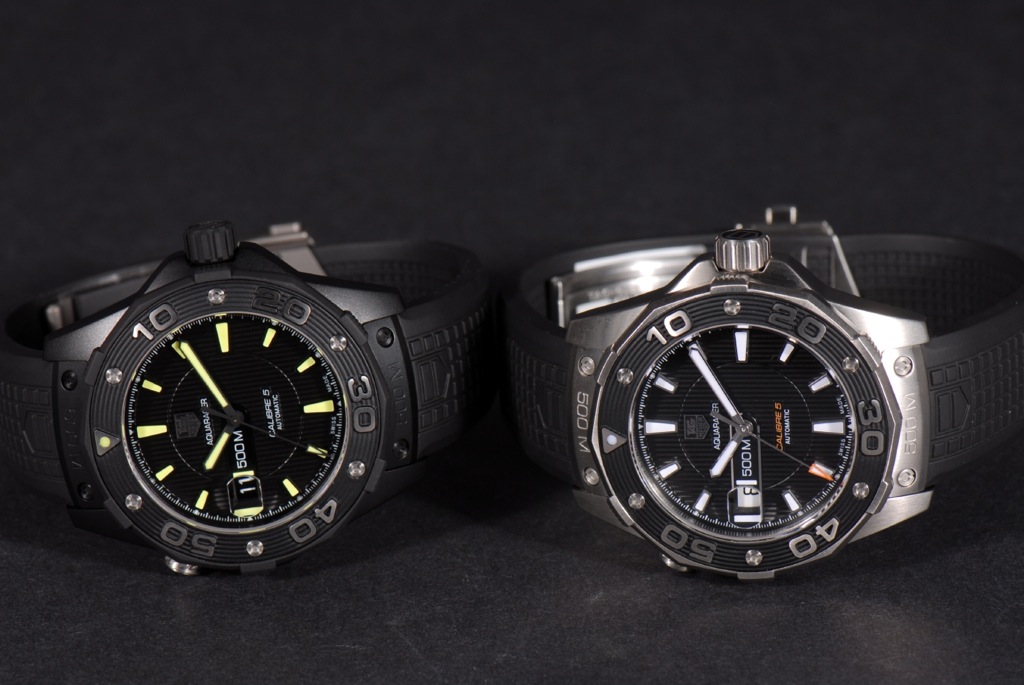 The 500m models gave the Aquaracer series a bolder, more modern design and one that proved popular, with both a quartz and automatic range of watches, including the “Full Black” Aquaracer with its bright lime highlights. The series was a winner. So why have TAG Heuer changed the formula?
The 500m models gave the Aquaracer series a bolder, more modern design and one that proved popular, with both a quartz and automatic range of watches, including the “Full Black” Aquaracer with its bright lime highlights. The series was a winner. So why have TAG Heuer changed the formula?
Design
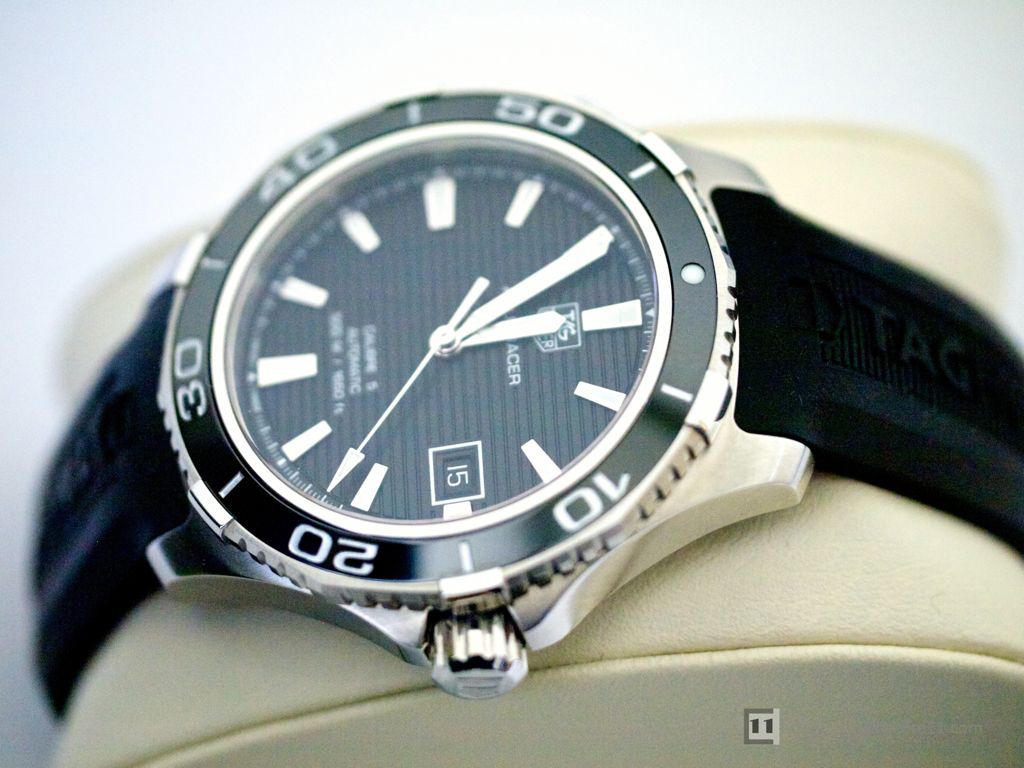 Let’s clear up one of the key questions about the new watch: the new Aquaracer 500m uses the same case as the Aquaracer 300m series, but with a thicker case back and bezel. If you think of the watch in three sections (case back, case and bezel), then the only external difference between the case of the two variants is the helium valve on the 500m models.
Let’s clear up one of the key questions about the new watch: the new Aquaracer 500m uses the same case as the Aquaracer 300m series, but with a thicker case back and bezel. If you think of the watch in three sections (case back, case and bezel), then the only external difference between the case of the two variants is the helium valve on the 500m models.
Inside the case, many components (such as gaskets) have been beefed up on the 500m to ensure water resistance to a greater depth.
It also means a 41mm case (down from 43mm) and the sharp edges of the out-going series replaced by the gentle curves of the original Heuer 2000. The similarities between the Aquaracer 300m and new 500m watches are clear when you see the two together:
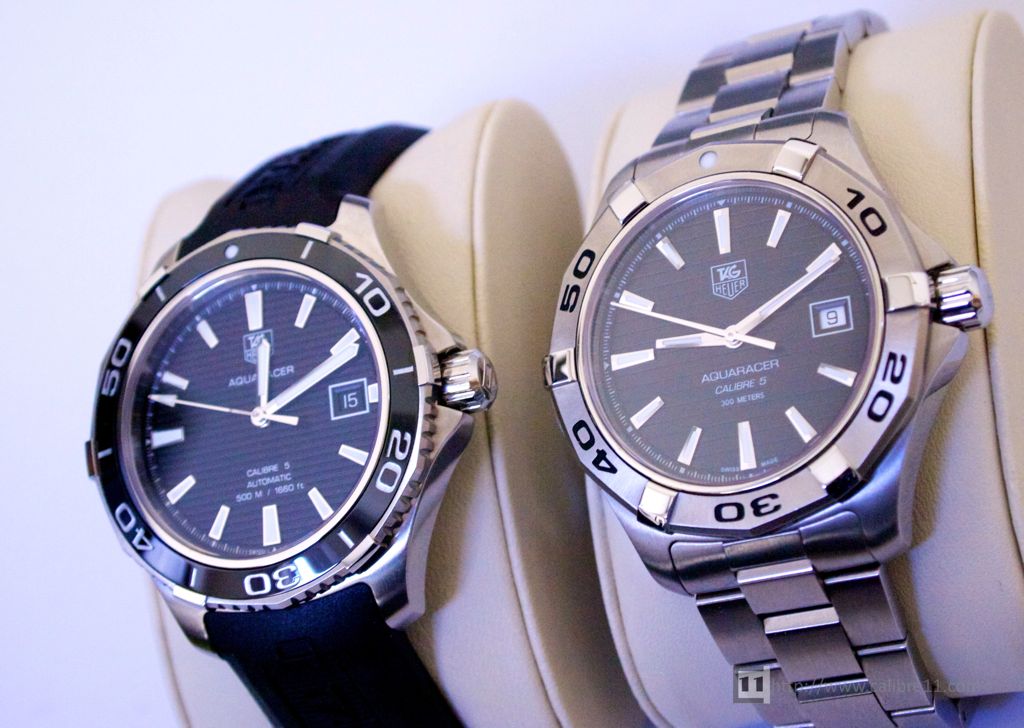 The 500m does score unique sword-shaped hands and carries over the design of the arrow-tipped sweeping seconds hand from the first generation Aquaracer 500m.
The 500m does score unique sword-shaped hands and carries over the design of the arrow-tipped sweeping seconds hand from the first generation Aquaracer 500m.
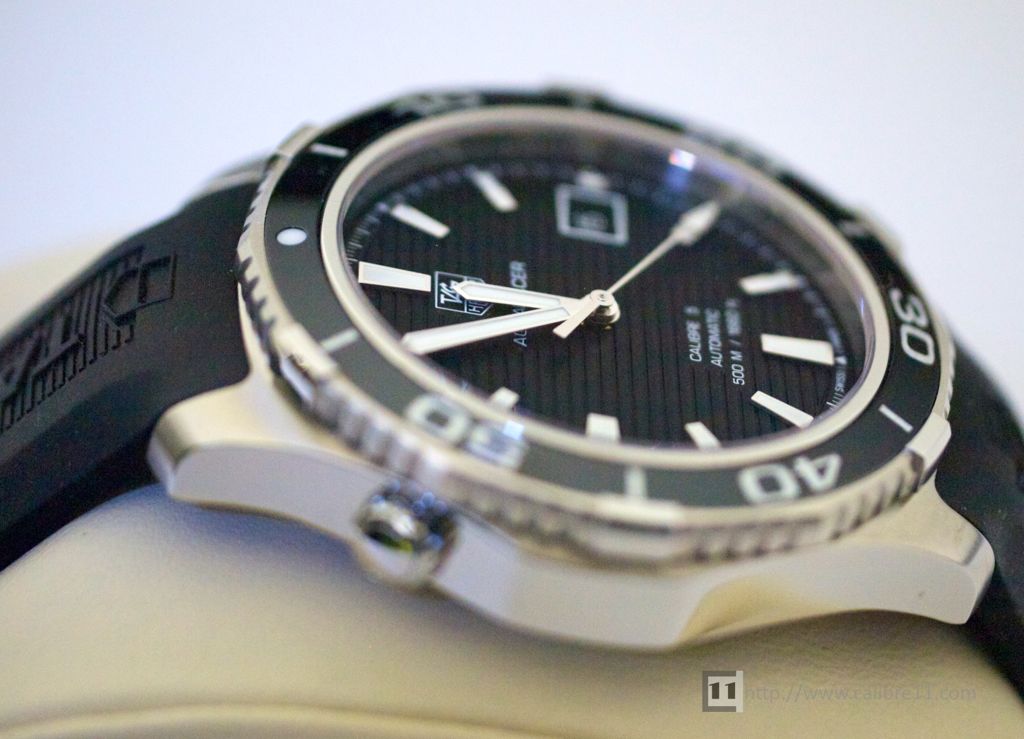 The dial design is also new. The first-gen model (below) has a bold vertical patterning, which has been replaced by toned-down horizontal effect on the new watches.
The dial design is also new. The first-gen model (below) has a bold vertical patterning, which has been replaced by toned-down horizontal effect on the new watches.
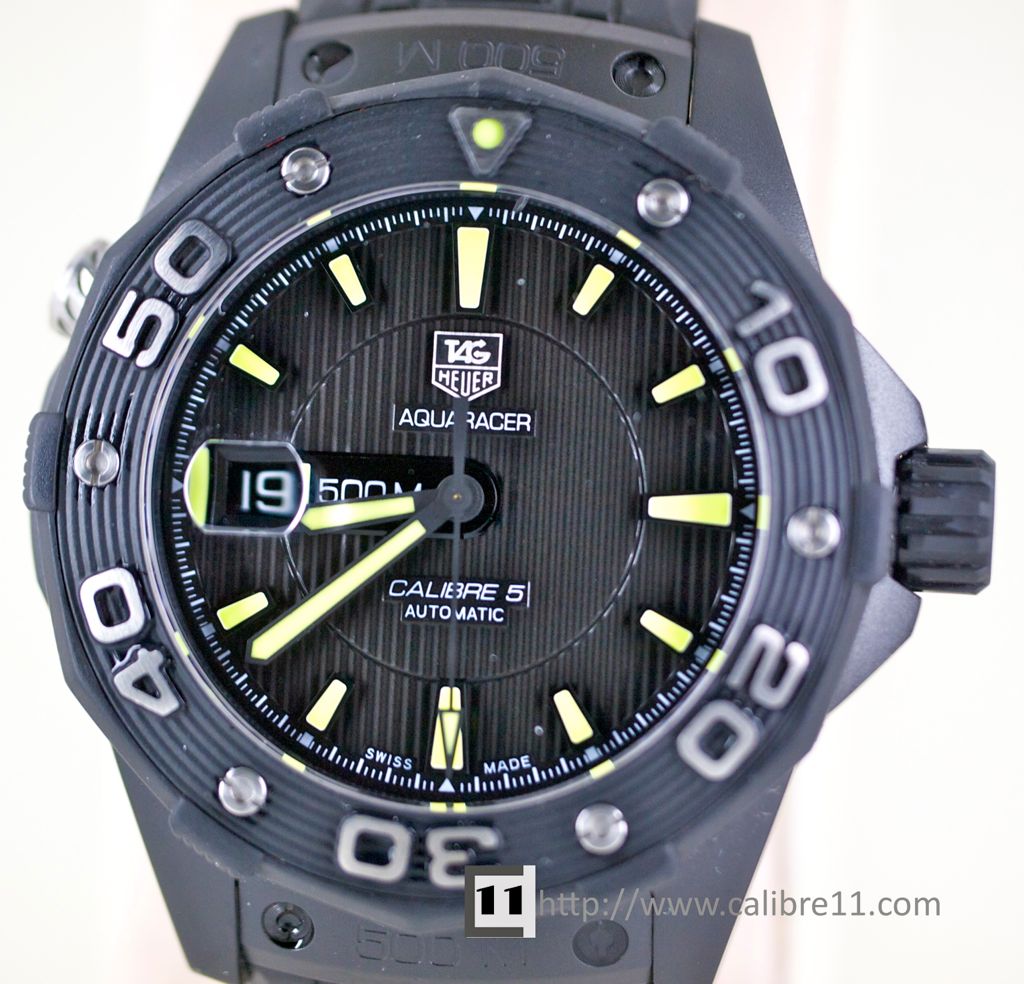
The streaks are smaller than those on the 300m model and work well in giving the dial a more classical look (below).
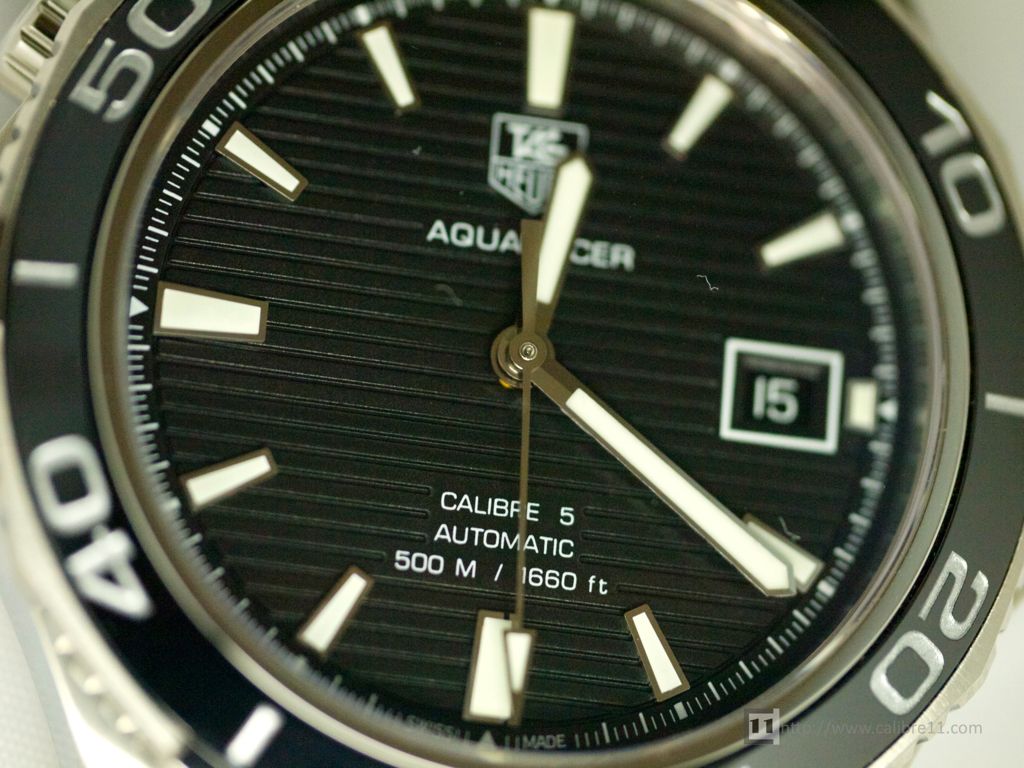 The date window on the new 500m moves back to the traditional 3 o’clock position and the dial loses the “500m” bridge that linked the centre-stem to the date window. And speaking of date windows, the cyclops is gone.
The date window on the new 500m moves back to the traditional 3 o’clock position and the dial loses the “500m” bridge that linked the centre-stem to the date window. And speaking of date windows, the cyclops is gone.
Another detailed change is the reversion to a printed “TAG Heuer” logo rather than the applied logo of the first-gen watch.
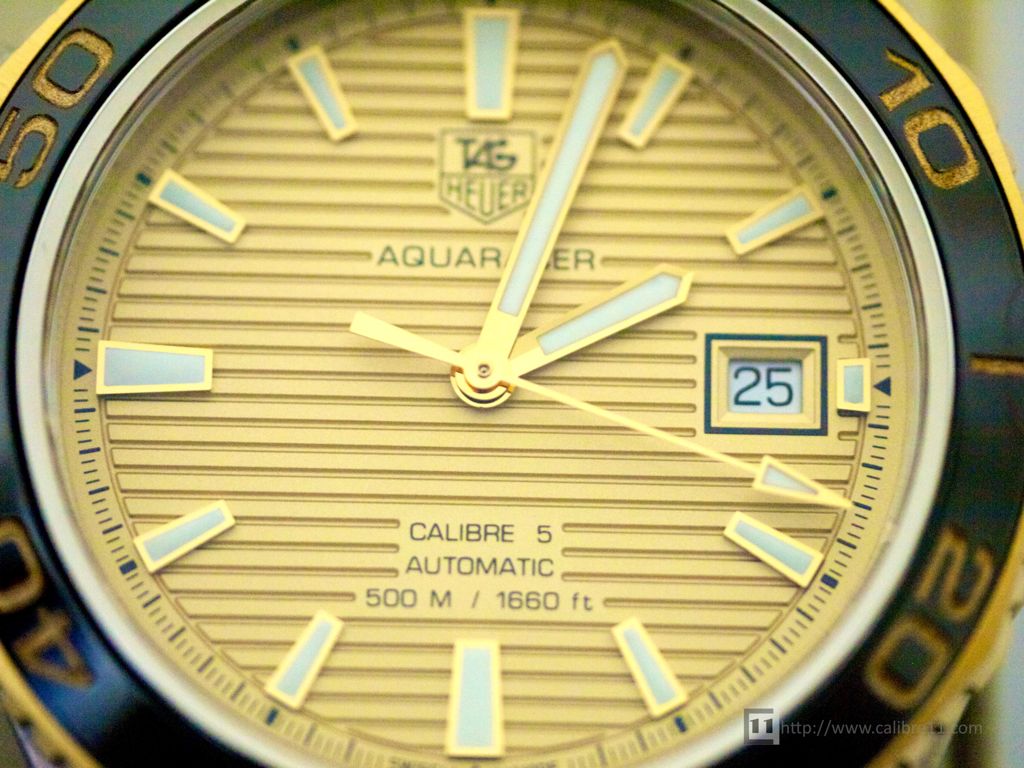 Moving away from the dial, one of the most significant improvements to the watch is the new bezel-insert, where the hard rubber bezel has been replaced by a great-looking ceramic bezel in the traditional dive-watch style. For me, this is a huge improvement and one advocated two years ago when Calibre 11 reviewed the 500m Chronograph:
Moving away from the dial, one of the most significant improvements to the watch is the new bezel-insert, where the hard rubber bezel has been replaced by a great-looking ceramic bezel in the traditional dive-watch style. For me, this is a huge improvement and one advocated two years ago when Calibre 11 reviewed the 500m Chronograph:
“A quick word about the bezel- one of the controversial features of the Aquaracer 500m series. The bezel is a hard rubber finish that looks great with the applied silver markers and the exposed screw-heads. But while the design works well as a diving watch, it doesn’t look as up-market as a traditional metal bezel. I would have kept this distinctive bezel design as a feature of the 500m watch and used a ceramic bezel on the Chronograph version to distinguish it from the basic watch and give the Chronograph a more up-market appearance.”
Being ceramic, the new bezel has a smooth, “glassy” finish and the added benefit of being significantly harder (and therefore more scratch resistant) than a traditional aluminum bezel.
Comparing the Aquaracer 500m Ceramic
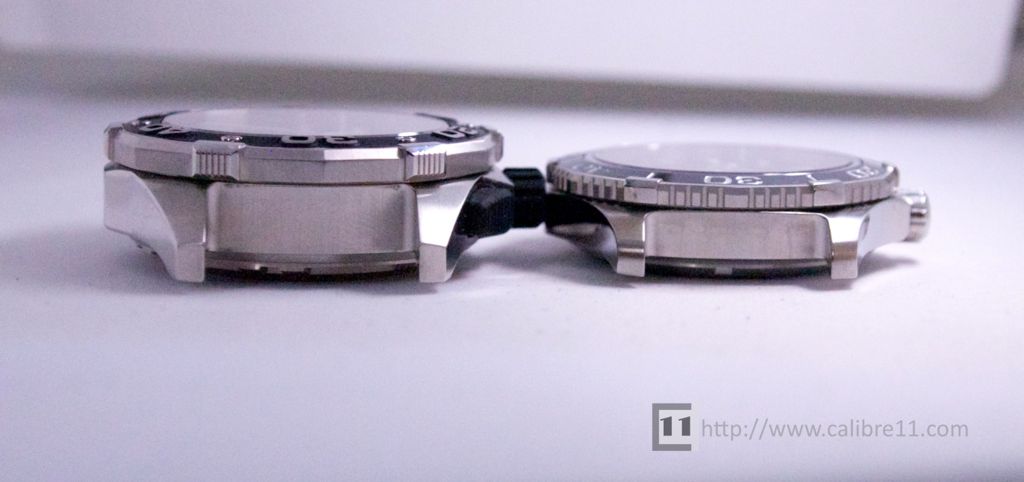 Nothing sums up the slimmer design of the new Aquaracer 500m watch more clearly than the photo above, which shows the new watch on the right and the current Aquaracer 500m Chronograph on the left. Sure, Chronographs are usually thicker than 3-hand watches, but the difference is stark.
Nothing sums up the slimmer design of the new Aquaracer 500m watch more clearly than the photo above, which shows the new watch on the right and the current Aquaracer 500m Chronograph on the left. Sure, Chronographs are usually thicker than 3-hand watches, but the difference is stark.
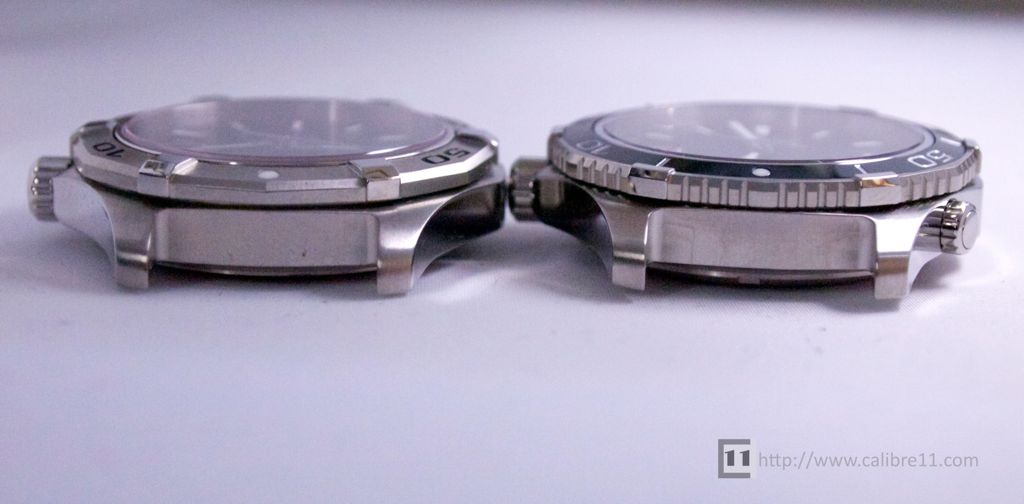 The photo above shows the new Aquaracer 500m (right) up against the 300m Aquaracer (left). Note how the 500m sits higher thanks to its thicker caseback. You can also clearly see the differences in the bezel design and thickness.
The photo above shows the new Aquaracer 500m (right) up against the 300m Aquaracer (left). Note how the 500m sits higher thanks to its thicker caseback. You can also clearly see the differences in the bezel design and thickness.
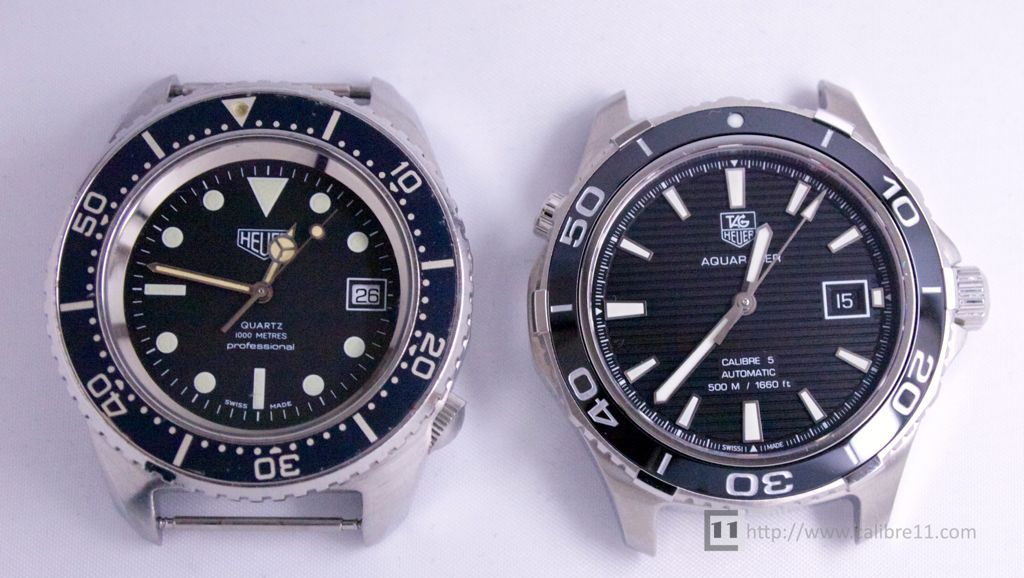 And, for the vintage buffs, here is the new Aquaracer 500m up against the Heuer 1000m deep dive watch from the early 1980s. Considered an over-sized “tool watch” in its day, the Heuer 1000m is about the same size as the new Aquaracer. Take a look at the same vintage Heuer alongside the Aquaracer 500m Chronograph (below).
And, for the vintage buffs, here is the new Aquaracer 500m up against the Heuer 1000m deep dive watch from the early 1980s. Considered an over-sized “tool watch” in its day, the Heuer 1000m is about the same size as the new Aquaracer. Take a look at the same vintage Heuer alongside the Aquaracer 500m Chronograph (below).
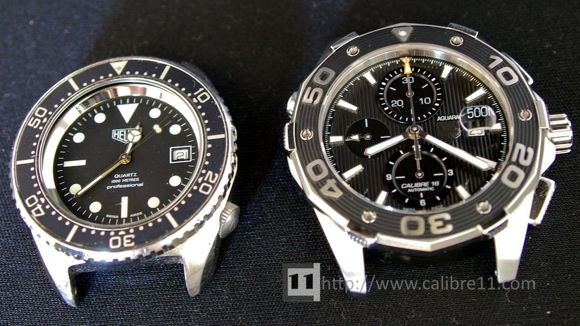 TAG Heuer boast that the new Aquaracer 500m is the thinnest automatic watch rated to 500m water resistance, and there is no doubt that after an era of over-sized diver watches, the new model looks and feels considerably lighter. Whether you consider the new design classical or conservative, there is no doubt that it’s a good-looking watch.
TAG Heuer boast that the new Aquaracer 500m is the thinnest automatic watch rated to 500m water resistance, and there is no doubt that after an era of over-sized diver watches, the new model looks and feels considerably lighter. Whether you consider the new design classical or conservative, there is no doubt that it’s a good-looking watch.
Aquaracer 500m WAK2110- Black Dial
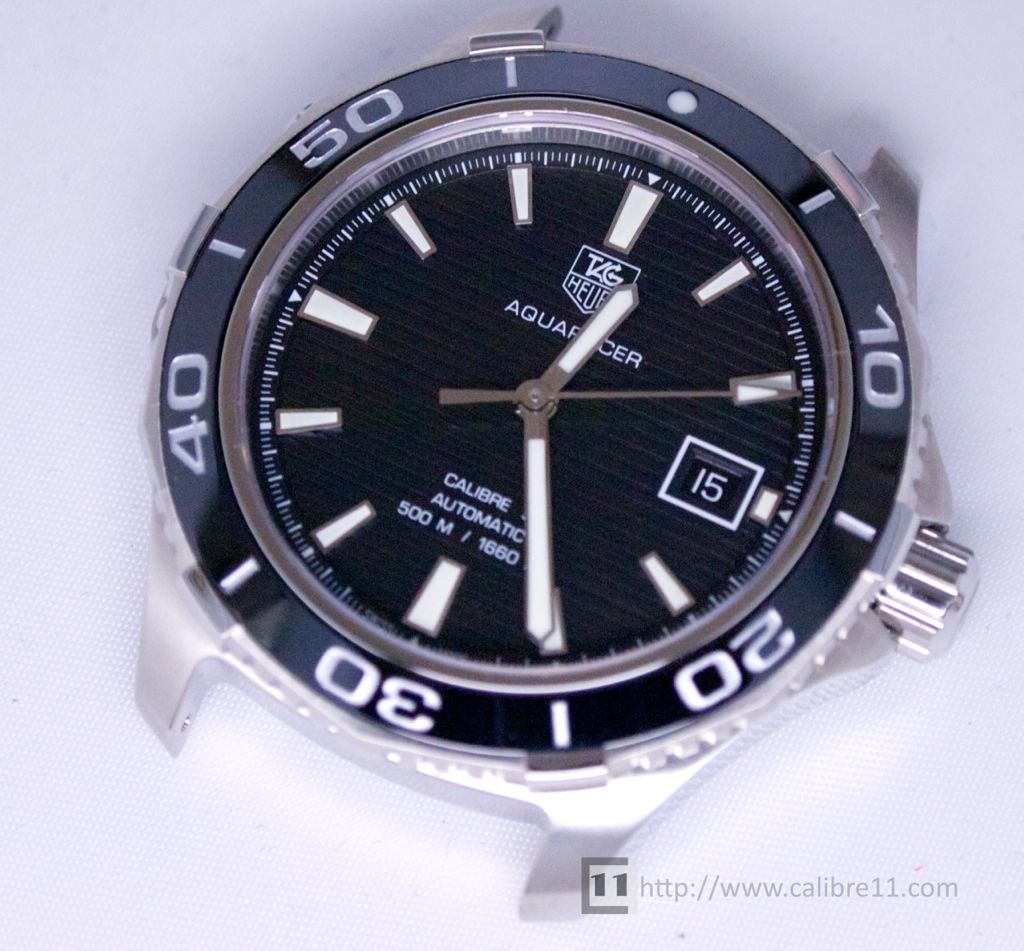 The most popular version of the new series will almost certainly be the black dial/ black bezel version- almost the default colour combination for dive watches (think Rolex Submariner and Omega Planet Ocean). It’s my favourite of the new range (although I would love to have seen the titanium Full Black version) and looks great.
The most popular version of the new series will almost certainly be the black dial/ black bezel version- almost the default colour combination for dive watches (think Rolex Submariner and Omega Planet Ocean). It’s my favourite of the new range (although I would love to have seen the titanium Full Black version) and looks great.
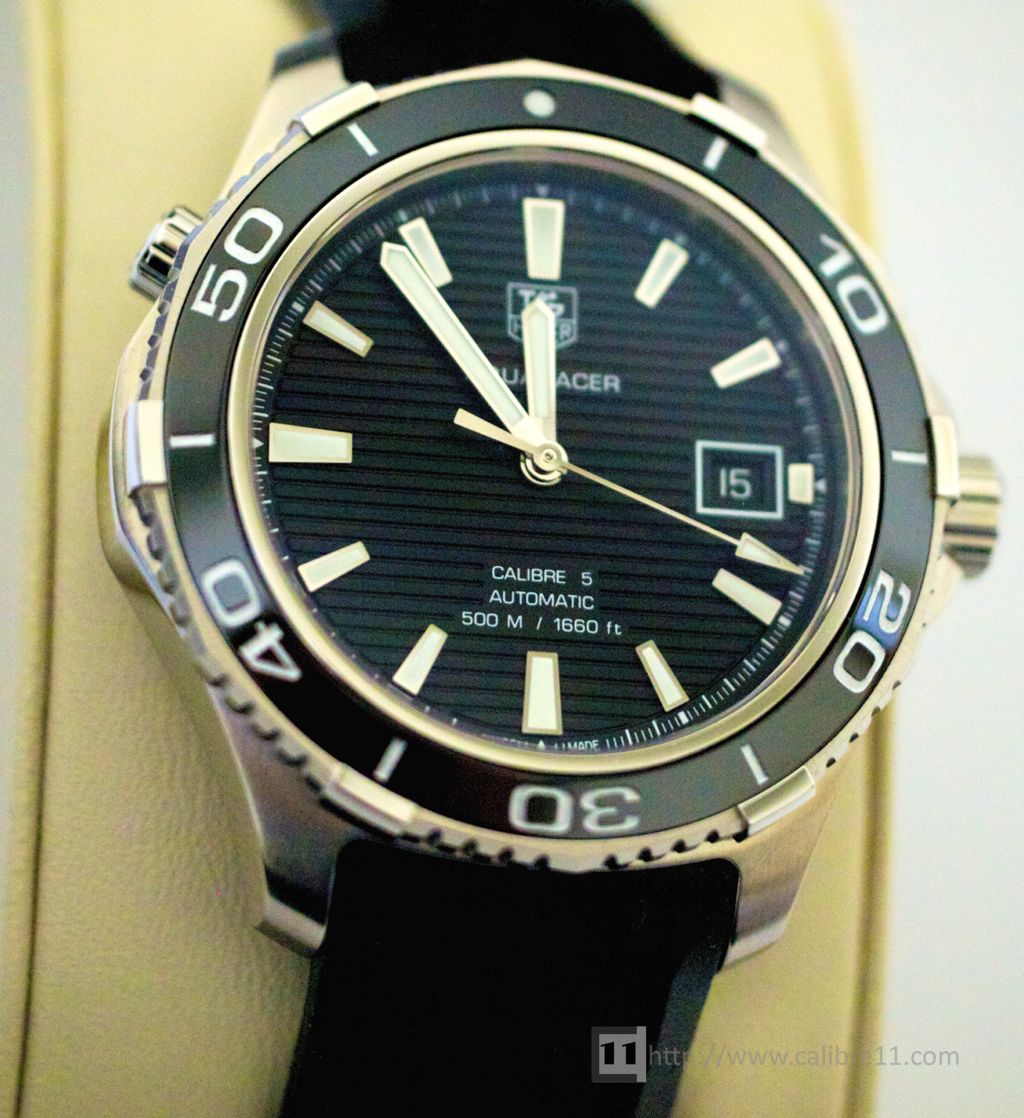 In addition to the black-dial model above, the stainless steel Aquaracer 500m is also available with a blue dial that is teamed with a great-looking blue bezel.
In addition to the black-dial model above, the stainless steel Aquaracer 500m is also available with a blue dial that is teamed with a great-looking blue bezel.
Aquaracer 500m WAK2121- Champagne Dial
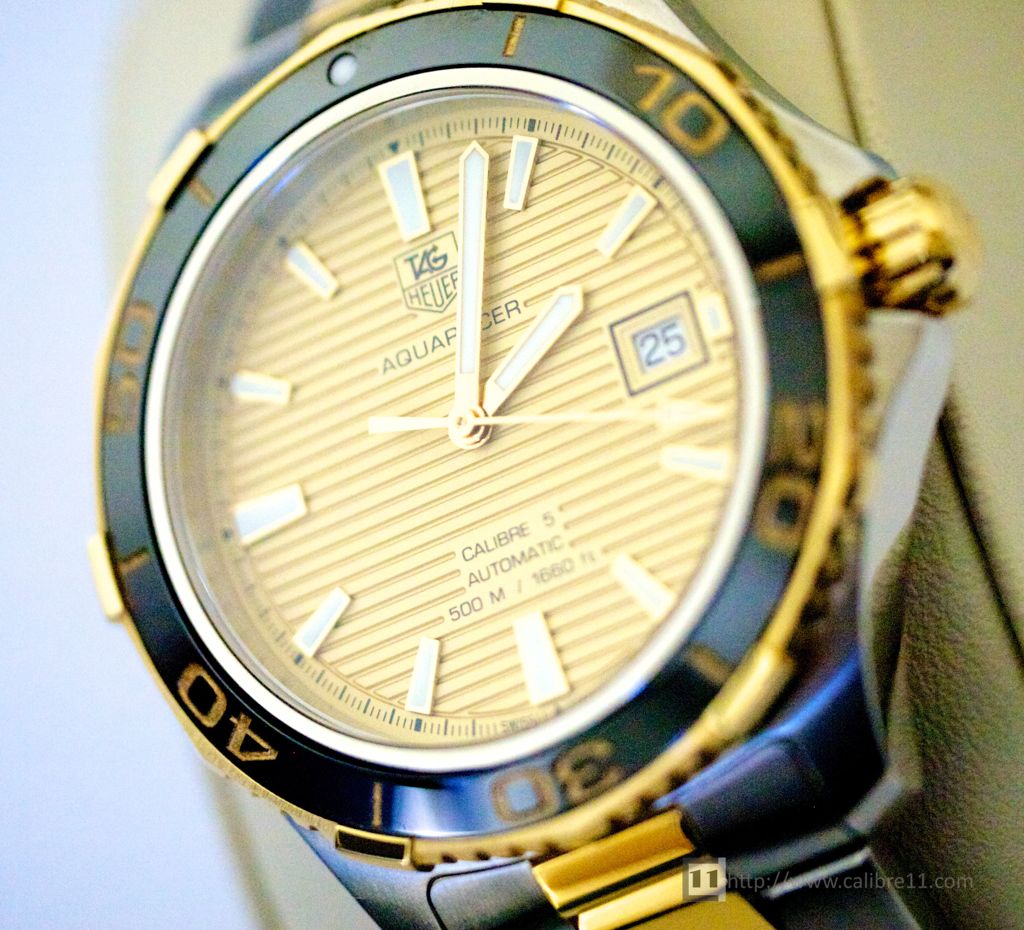 As an alternative to stainless steel, there are two Steel & Gold (Plated) models available- one with a blue dial and the second (a dealer special order) with a “Champagne”- coloured dial.
As an alternative to stainless steel, there are two Steel & Gold (Plated) models available- one with a blue dial and the second (a dealer special order) with a “Champagne”- coloured dial.
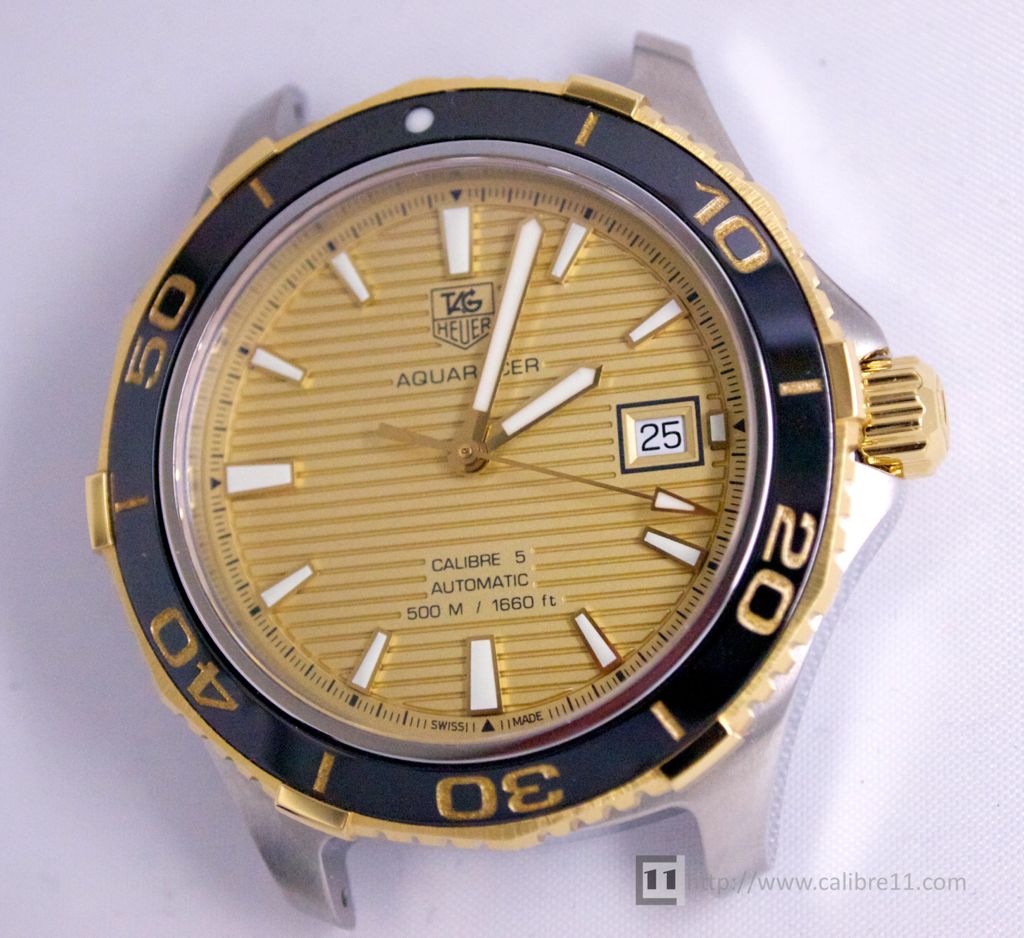 While I’ve never been a fan of the bi-metal look, TAG Heuer has offered this variation for more than 30 years now and there is certainly a market for the Gold and Steel look- especially on watches aimed at the Yachting market.
While I’ve never been a fan of the bi-metal look, TAG Heuer has offered this variation for more than 30 years now and there is certainly a market for the Gold and Steel look- especially on watches aimed at the Yachting market.
Caseback
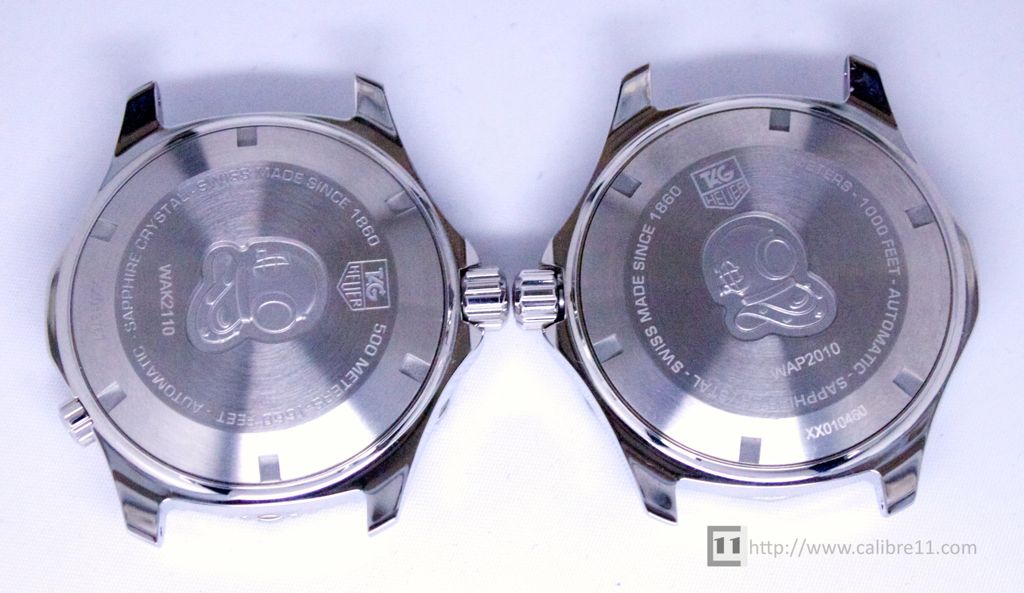 The new Aquaracer 500m retains the dive-helmet design of the 300m model, losing the sapphire case-back of the first-gen watch. As you can see, apart from the thickness, the two designs are identical (new 500m above left).
The new Aquaracer 500m retains the dive-helmet design of the 300m model, losing the sapphire case-back of the first-gen watch. As you can see, apart from the thickness, the two designs are identical (new 500m above left).
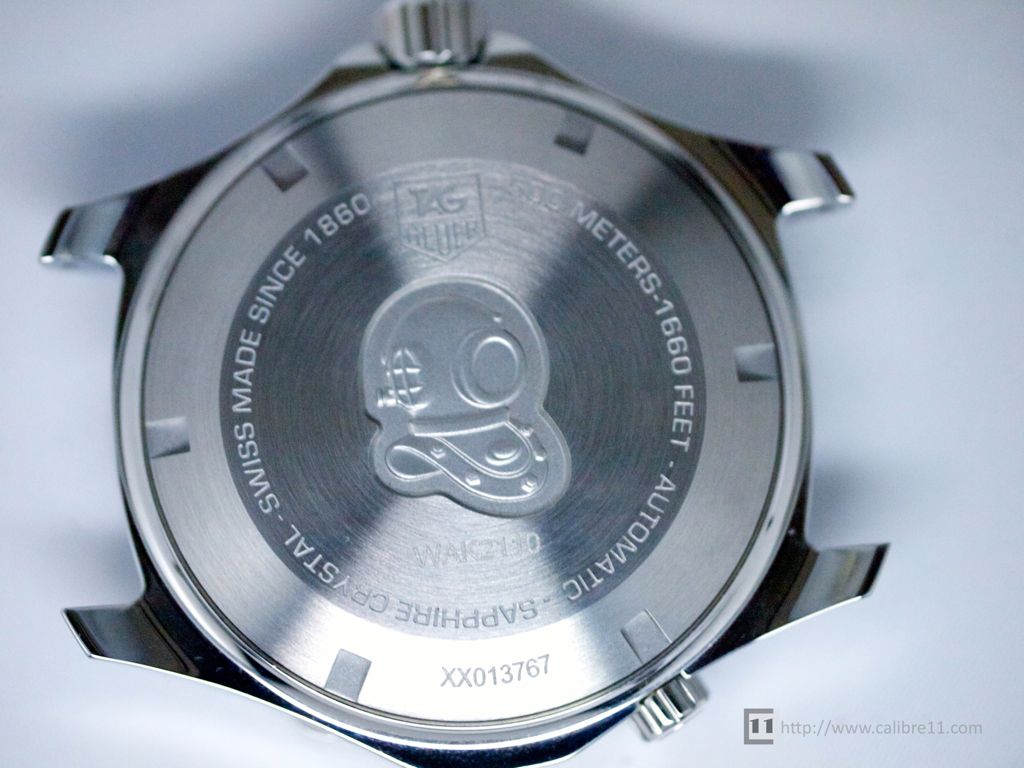
Movement
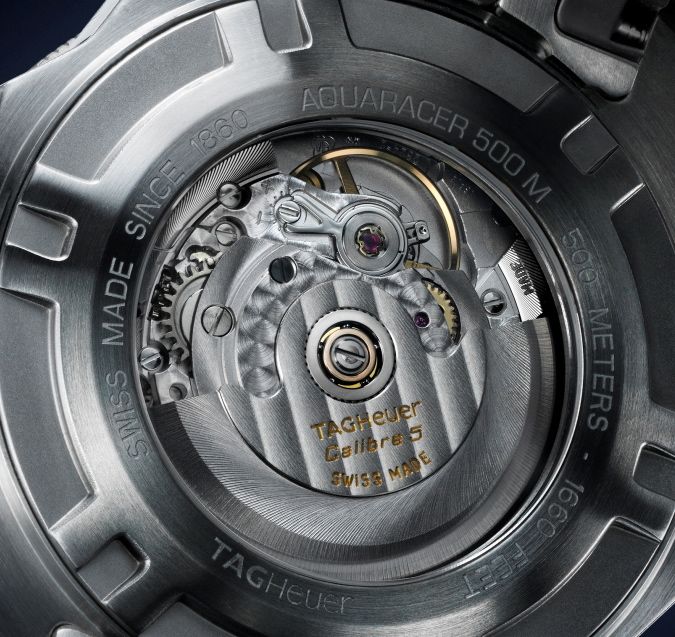 As regular readers will know, TAG Heuer is in a phase of moving away from ETA movements, which will mean more in-house movements (such as the Calibre “1888”) and a greater spread of movements from specialists such as Sellita, Soprod and Dubois-Depraz.
As regular readers will know, TAG Heuer is in a phase of moving away from ETA movements, which will mean more in-house movements (such as the Calibre “1888”) and a greater spread of movements from specialists such as Sellita, Soprod and Dubois-Depraz.
Like the Aquaracer 300m, the new 500m model uses TAG Heuer’s Calibre 5 movement (shown above in the first-gen Aquaracer 500m), which can be either an ETA 2824-2 or the Sellita equivalent, the SW200. The movements are being used interchangeably, so two identical watches in a store may have movements from different suppliers. Expect the balance between ETA and Sellita to tilt heavily towards Sellita as ETA supply winds down.
The quartz version of the Aquaracer 500m has been dropped, consistent with the move towards an all-mechanical TAG Heuer range.
Straps & Bracelet
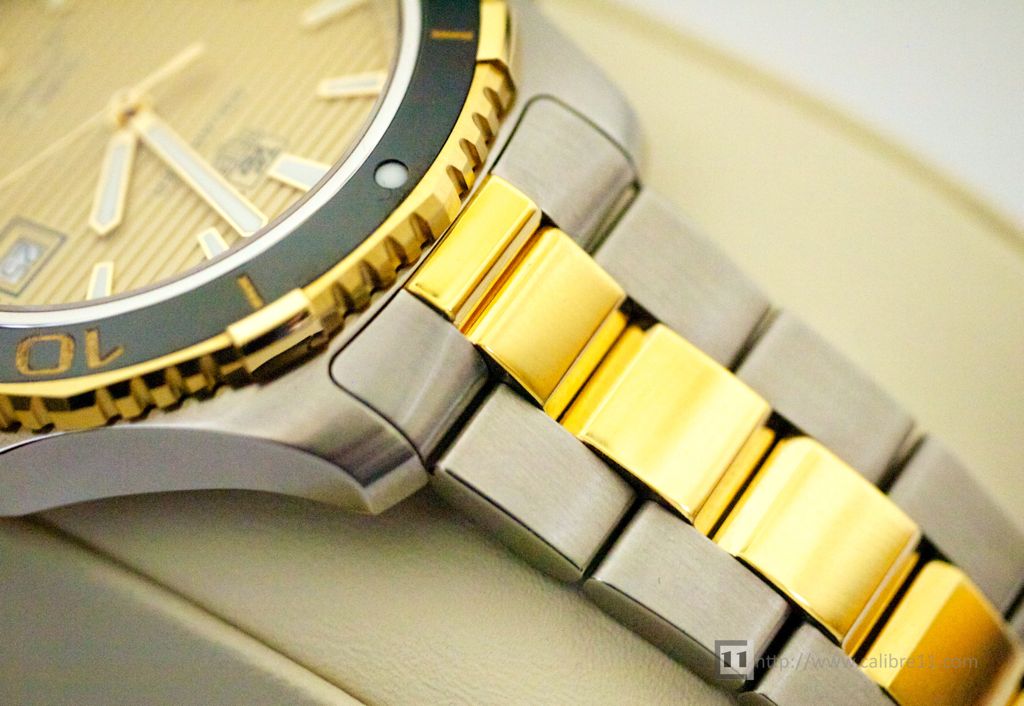 Given that the 500m shares its case with its 300m brother, its not surprising that the two models now also share bracelets and rubber straps.
Given that the 500m shares its case with its 300m brother, its not surprising that the two models now also share bracelets and rubber straps.
The previous model had 21mm lugs, with the strap attaching to the case via removable “end-pieces” with exposed screw heads (below).
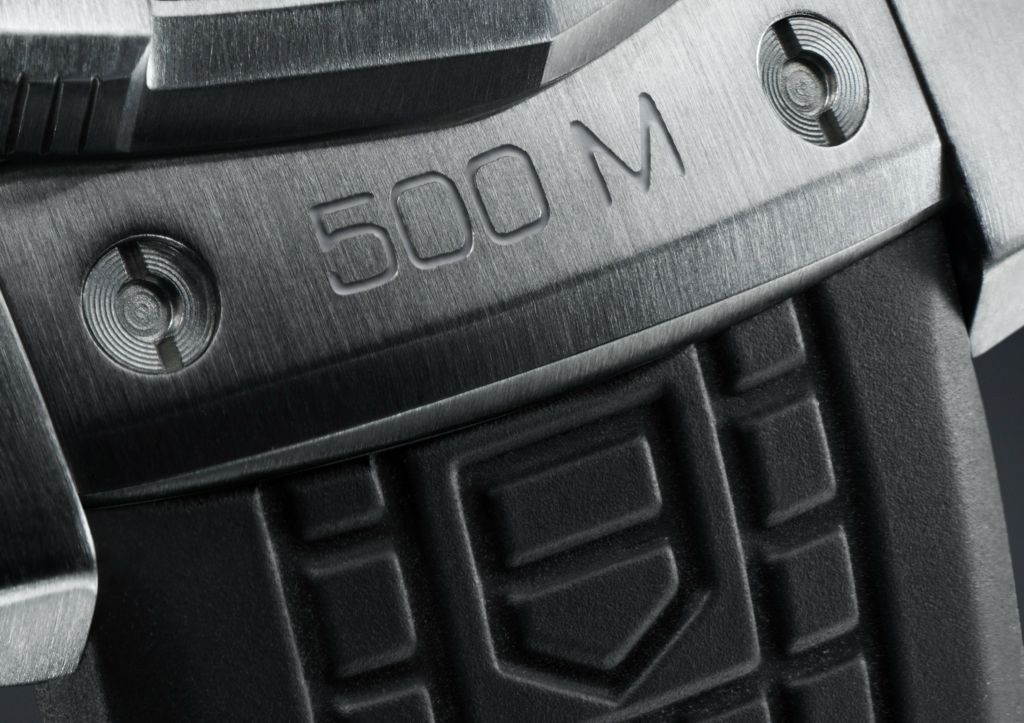 The new model is far simpler- fitting directly to the case- and better for it.
The new model is far simpler- fitting directly to the case- and better for it.
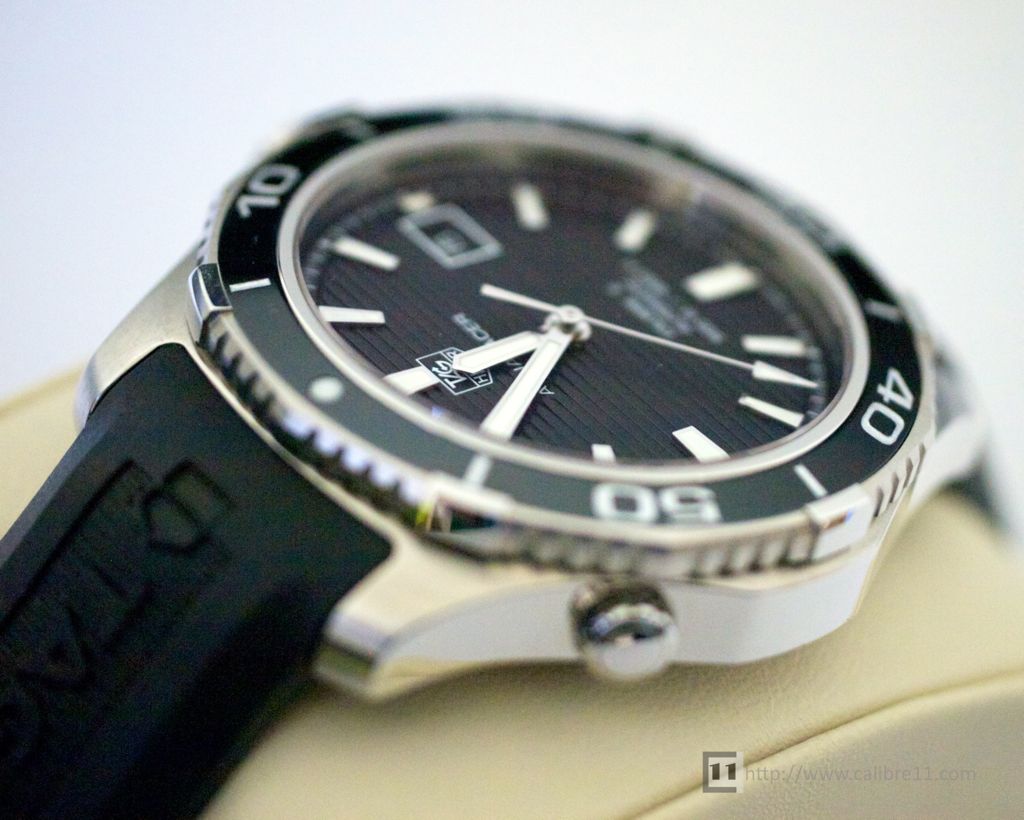
On the Wrist
 Having worn the Aquaracer 500m on both the rubber strap and bracelet, its the former that I prefer- more comfortable and to me, more in keeping with the spirit of the watch. The same watch as above on the bracelet is shown below:
Having worn the Aquaracer 500m on both the rubber strap and bracelet, its the former that I prefer- more comfortable and to me, more in keeping with the spirit of the watch. The same watch as above on the bracelet is shown below:
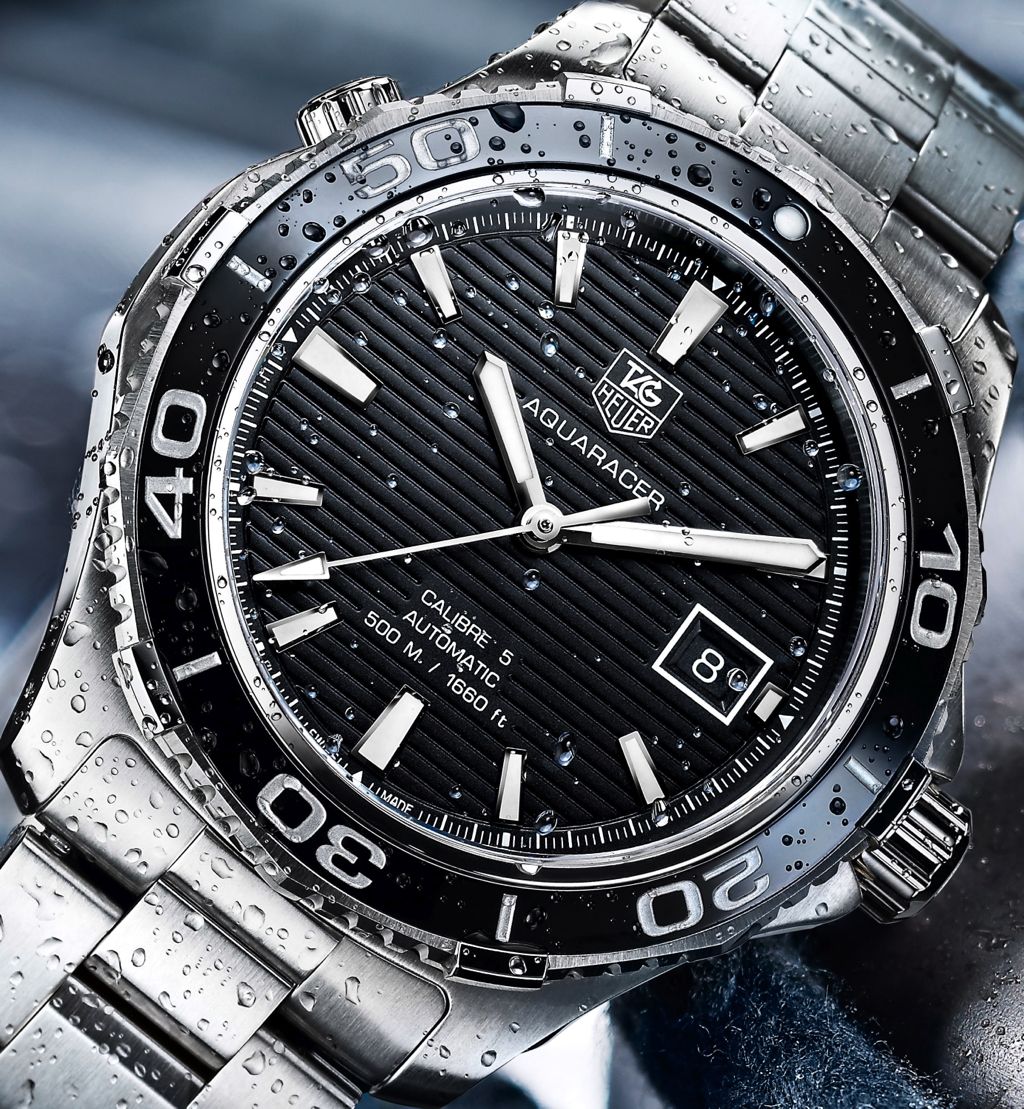 I also threw the watch on an old NATO strap, which also looks pretty good (above). NATO straps tend to fall in and out of fashion quickly, but I can see the chance for TAG Heuer to add an up-market NATO-style option, as Tudor and IWC have done for some of their recent releases.
I also threw the watch on an old NATO strap, which also looks pretty good (above). NATO straps tend to fall in and out of fashion quickly, but I can see the chance for TAG Heuer to add an up-market NATO-style option, as Tudor and IWC have done for some of their recent releases.

Price & Availability
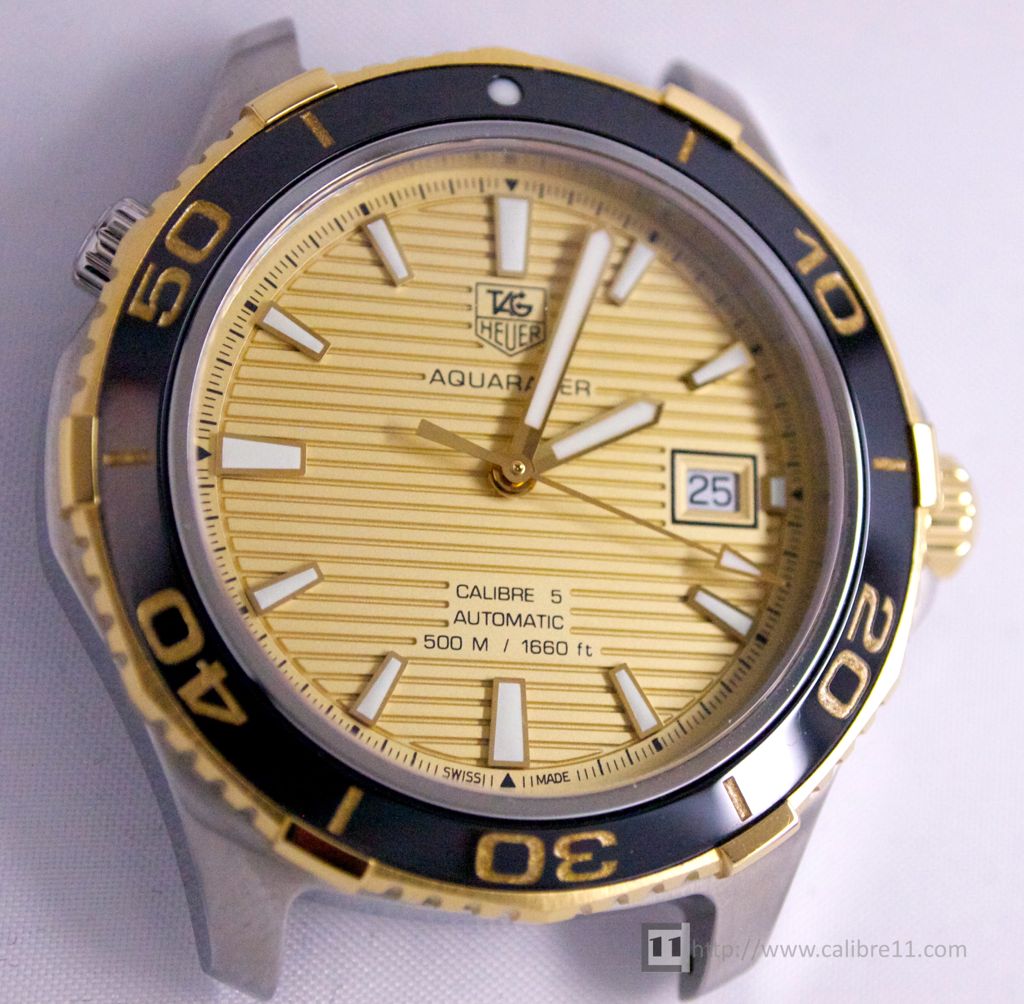 There are three price points for the 2012/ 2013 Aquaracer 500m series- all prices in Swiss Francs:
There are three price points for the 2012/ 2013 Aquaracer 500m series- all prices in Swiss Francs:
- Steel Case: CHF2,500
- Titanium Full Black: CHF 2,900 (below)
- Steel and Gold Plate: CHF 3,100
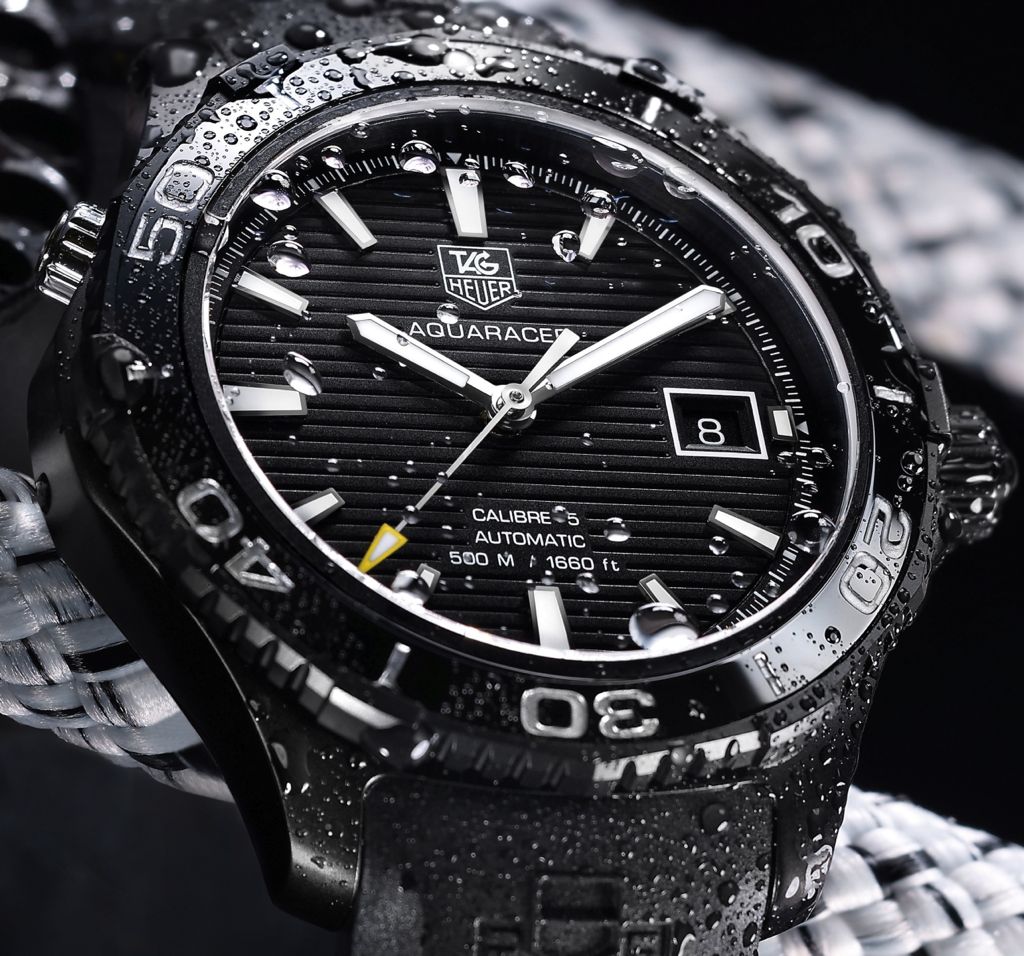
The watches will be available from October, with the Champagne Dial Steel and Gold watch shown here being a special order.
There have been some questions on whether the new Aquaracer 500m will complement the existing WAJ2XXX range, perhaps replacing the current Aquaracer 300m series: No, this 500m range replaces the current “WAJ” series and the Aquaracer 300m will continue.
Summary
 So, let’s return to the question posed at the start of the review: is the new TAG Heuer Aquaracer 500m ceramic a step forward from the first-generation watch? In short, yes, I believe the combination of a ceramic bezel (which needs to be seen in person to appreciate what a difference it makes) and a less fashion-orientated design does make the new watch one that I would buy ahead of the current watch.
So, let’s return to the question posed at the start of the review: is the new TAG Heuer Aquaracer 500m ceramic a step forward from the first-generation watch? In short, yes, I believe the combination of a ceramic bezel (which needs to be seen in person to appreciate what a difference it makes) and a less fashion-orientated design does make the new watch one that I would buy ahead of the current watch.
But, there is no doubt that the new watch does not stand out from the crowd as much as the current model. It has all the “standard” diving watch features and looks…but what makes the new model distinct from others? The trade-off of this is that it’s not yet clear how several of the design flourishes on the first-gen Aquaracer 500m will look in 10 years time. The new design is far more classic.
This trend towards classic design continues the path established by the 2011 Link and 2012 Formula 1 models, each of which were more conservative designs, less “trendy” and featured smaller-diameter cases.
While a successful re-design, it does rob the Aquaracer range of some distinctiveness, so it will be interesting to see what other Aquaracer models TAG Heuer plans for 2013. There is no reason not to expect a revised 500m Chronograph to follow the same path as the 3-hand watch, but there is still space for a true, hard-core model to follow in the steps of the Super Professional and Aquagraph.
***

